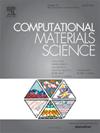Double lone pair electrons driving polar semiconductors and metals
IF 3.1
3区 材料科学
Q2 MATERIALS SCIENCE, MULTIDISCIPLINARY
引用次数: 0
Abstract
The lone pair electrons are important to understand the origin of polarization in ferroelectrics such as PbTiO3 and BiFeO3. Here we investigate the mechanism of polarization driven by double lone pair electrons in I-IV-V compounds. Our theoretical results indicate that these compounds can crystallize in three polar structures with P63mc symmetry. We identify 174 polar semiconductors and 109 potential polar metals that simultaneously exhibit electrical conductivity and spontaneous polarization. Particularly noteworthy are select polar semiconductors demonstrating promising photocatalytic potential, attributable to their intrinsic spontaneous polarization and optimal band gap characteristics. The study further reveals the emergence of bulk Rashba splitting phenomena, Dirac point features, and topological insulating states within these materials. These diverse physical manifestations stem from symmetry-breaking mechanisms in I-IV-V compounds containing double lone-pair electrons, which enable unique electronic structure modifications.

求助全文
约1分钟内获得全文
求助全文
来源期刊

Computational Materials Science
工程技术-材料科学:综合
CiteScore
6.50
自引率
6.10%
发文量
665
审稿时长
26 days
期刊介绍:
The goal of Computational Materials Science is to report on results that provide new or unique insights into, or significantly expand our understanding of, the properties of materials or phenomena associated with their design, synthesis, processing, characterization, and utilization. To be relevant to the journal, the results should be applied or applicable to specific material systems that are discussed within the submission.
 求助内容:
求助内容: 应助结果提醒方式:
应助结果提醒方式:


